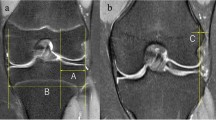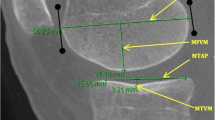Abstract
Purpose
The purpose of this study was to describe meniscus extrusion, present imaging characteristics, and provide clinical correlations for patients with isolated meniscus extrusion.
Methods
Of the 3244 MRI reports identified as having meniscus extrusion, 20 patients were identified to have isolated meniscus extrusion (0.62%). Patients with moderate to severe chondromalacia, meniscus tears, intra-articular fractures, tumours, and ligament tears were excluded. Radiographs were reviewed and graded using Kellgren–Lawrence (K–L) scores. MRI’s were reviewed for the extent of extrusion and whether or not the meniscotibial ligament was intact. Clinical presentation and management were recorded.
Results
The study population consisted of 12 females and 8 males with a mean age of 40.5, diagnosed with meniscus extrusion and minimal concomitant knee pathology. 68% of patients were considered symptomatic as their knee pain correlated with the side of their meniscus extrusion and no other reason for pain was identified. The mean amount of meniscus extrusion was 2.5 mm (SD ± 1.1 mm) with 45% (9 of 20) having 3 + mm of extrusion. Meniscotibial ligament abnormality was identified in 65% of cases (13 of 20). Patients with 3 + mm of meniscus extrusion were much more likely to have associated meniscotibial ligament abnormality (100%, 9 of 9) compared to those with < 3 mm of extrusion (36%, 4 of 11) (RR 2.75, p = 0.048). The mean K–L grade obtained at the initial visit was 0.9 (95% CI 0.7–1.4) and the mean K–L grade obtained on final follow-up was 1.3 (95% CI 0.8–2.8) (n.s.) at a mean of 44.7 months. No correlation was found between K–L grade, gender, age, acute injury, and BMI in relation to meniscotibial ligament abnormality or amount of meniscal extrusion.
Conclusions
Meniscus extrusion often occurs in the presence of significant knee pathology, predominantly with meniscus tears or osteoarthritis. Isolated meniscus extrusion is a rare occurrence that may present clinically with knee pain, commonly to the side in which the extrusion occurs. In patients with three or more millimetres of meniscus extrusion, an intact meniscus and minimal knee pathology, meniscotibial ligament abnormality is likely. This may provide an opportunity to treat the meniscotibial ligament abnormality with meniscus centralisation technique and decrease the amount of meniscus extrusion.




Similar content being viewed by others
References
Acebes C, Romero FI, Contreras MA, Mahillo I, Herrero-Beaumont G (2013) Dynamic ultrasound assessment of medial meniscal subluxation in knee osteoarthritis. Rheumatology (Oxford) 52:1443–1447
Achtnich A, Petersen W, Willinger L, Sauter A, Rasper M, Wortler K et al (2018) Medial meniscus extrusion increases with age and BMI and is depending on different loading conditions. Knee Surg Sports Traumatol Arthrosc 26:2282–2288
Agresti A, Coull BA (1998) Approximate is better than “Exact” for interval estimation of binomial proportions. Am Stat 52:119–126
Berthiaume MJ, Raynauld JP, Martel-Pelletier J, Labonte F, Beaudoin G, Bloch DA et al (2005) Meniscal tear and extrusion are strongly associated with progression of symptomatic knee osteoarthritis as assessed by quantitative magnetic resonance imaging. Ann Rheum Dis 64:556–563
Bikkina RS, Tujo CA, Schraner AB, Major NM (2005) The “floating” meniscus: MRI in knee trauma and implications for surgery. AJR Am J Roentgenol 184:200–204
Black AK, Schlepp C, Zapf M, Reid JB 3rd (2018) Technique for arthroscopically assisted superficial and deep medial collateral ligament-meniscotibial ligament repair with internal brace augmentation. Arthrosc Tech 7:e1215–e1219
Choi CJ, Choi YJ, Lee JJ, Choi CH (2010) Magnetic resonance imaging evidence of meniscal extrusion in medial meniscus posterior root tear. Arthroscopy 26:1602–1606
Costa CR, Morrison WB, Carrino JA (2004) Medial meniscus extrusion on knee MRI: Is extent associated with severity of degeneration or type of tear? AJR Am J Roentgenol 183:17–23
Crema MD, Roemer FW, Felson DT, Englund M, Wang K, Jarraya M et al (2012) Factors associated with meniscal extrusion in knees with or at risk for osteoarthritis: the multicenter osteoarthritis study. Radiology 264:494–503
De Smet AA, Tuite MJ (2006) Use of the “two-slice-touch” rule for the MRI diagnosis of meniscal tears. AJR Am J Roentgenol 187:911–914
Ding C, Martel-Pelletier J, Pelletier JP, Abram F, Raynauld JP, Cicuttini F et al (2007) Knee meniscal extrusion in a largely non-osteoarthritic cohort: association with greater loss of cartilage volume. Arthritis Res Ther 9:R21
El-Khoury GY, Usta HY, Berger RA (1984) Meniscotibial (coronary) ligament tears. Skeletal Radiol 11:191–196
Fithian DC, Kelly MA, Mow VC (1990) Material properties and structure-function relationships in the menisci. Clin Orthop Relat Res (252):19–31
Gale DR, Chaisson CE, Totterman SM, Schwartz RK, Gale ME, Felson D (1999) Meniscal subluxation: association with osteoarthritis and joint space narrowing. Osteoarthritis Cartilage 7:526–532
Goto N, Okazaki K, Akiyama T, Akasaki Y, Mizu-Uchi H, Hamai S et al (2018) Alignment factors affecting the medial meniscus extrusion increases the risk of osteoarthritis development. Knee Surg Sports Traumatol Arthrosc. https://doi.org/10.1007/s00167-018-5286-7
Hunter DJ, Zhang YQ, Niu JB, Tu X, Amin S, Clancy M et al (2006) The association of meniscal pathologic changes with cartilage loss in symptomatic knee osteoarthritis. Arthritis Rheum 54:795–801
Kawaguchi K, Enokida M, Otsuki R, Teshima R (2012) Ultrasonographic evaluation of medial radial displacement of the medial meniscus in knee osteoarthritis. Arthritis Rheum 64:173–180
Kellgren JH, Lawrence JS (1957) Radiological assessment of osteo-arthrosis. Ann Rheum Dis 16:494–502
Kenny C (1997) Radial displacement of the medial meniscus and Fairbank’s signs. Clin Orthop Relat Res 339:163–173
Koenig JH, Ranawat AS, Umans HR, Difelice GS (2009) Meniscal root tears: diagnosis and treatment. Arthroscopy 25:1025–1032
Lerer DB, Umans HR, Hu MX, Jones MH (2004) The role of meniscal root pathology and radial meniscal tear in medial meniscal extrusion. Skeletal Radiol 33:569–574
Lougher L, Southgate CR, Holt MD (2003) Coronary ligament rupture as a cause of medial knee pain. Arthroscopy 19:E19–E20
Magee T (2008) MR findings of meniscal extrusion correlated with arthroscopy. J Magn Reson Imaging 28:466–470
Miller TT, Staron RB, Feldman F, Cepel E (1997) Meniscal position on routine MR imaging of the knee. Skeletal Radiol 26:424–427
Puig L, Monllau JC, Corrales M, Pelfort X, Melendo E, Caceres E (2006) Factors affecting meniscal extrusion: correlation with MRI, clinical, and arthroscopic findings. Knee Surg Sports Traumatol Arthrosc 14:394–398
Smigielski R, Becker R, Zdanowicz U, Ciszek B (2015) Medial meniscus anatomy-from basic science to treatment. Knee Surg Sports Traumatol Arthrosc 23:8–14
Swamy N, Wadhwa V, Bajaj G, Chhabra A, Pandey T (2018) Medial meniscal extrusion: detection, evaluation and clinical implications. Eur J Radiol 102:115–124
Wang Y, Wluka AE, Pelletier JP, Martel-Pelletier J, Abram F, Ding C et al (2010) Meniscal extrusion predicts increases in subchondral bone marrow lesions and bone cysts and expansion of subchondral bone in osteoarthritic knees. Rheumatology (Oxford) 49:997–1004
Funding
There was no outside funding or grants received that assisted in this study.
Author information
Authors and Affiliations
Corresponding author
Ethics declarations
Conflict of interest
All authors declare that they have no conflict of interest.
Ethical approval
All procedures performed in studies involving human participants were in accordance with the ethical standards of the institutional and/or national research committee (Mayo Clinic Institution: IRB ID# 15-000601) and with the 1964 Helsinki declaration and its later amendments or comparable ethical standards.
Additional information
Publisher's Note
Springer Nature remains neutral with regard to jurisdictional claims in published maps and institutional affiliations.
Rights and permissions
About this article
Cite this article
Krych, A.J., Bernard, C.D., Leland, D.P. et al. Isolated meniscus extrusion associated with meniscotibial ligament abnormality. Knee Surg Sports Traumatol Arthrosc 28, 3599–3605 (2020). https://doi.org/10.1007/s00167-019-05612-1
Received:
Accepted:
Published:
Issue Date:
DOI: https://doi.org/10.1007/s00167-019-05612-1




